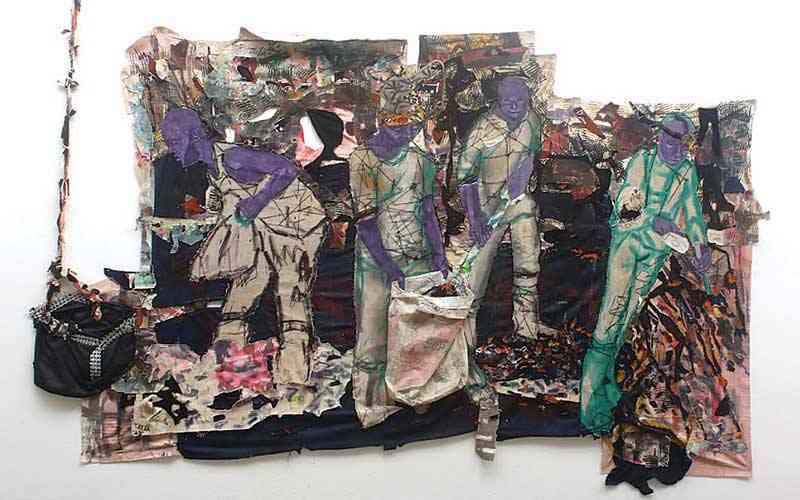
IT is long after the post-COVID-19 bounce back of the visual art sector as Zimbabwe started to show its natural trajectory and a lethargic pace in growth. Zimbabwean visual artists continue to shine locally but earn greater rewards and appreciation across the continent and overseas.
On the local scene the National Gallery of Zimbabwe (NGZ) guided by its mandate from the government delivered the blockbuster show Vestiges of Colonialism by Moffat Takadiwa. The exhibition was supported by Nicodim Gallery which represents Takadiwa in the United States and Semiose Gallery that represents him in Paris.
The show clearly smashed attendance records for the year and attracted local celebrities and socialites from across the social spectrum including renowned personalities from other genres such as film, music and literature.
A lesson from Takadiwa’s historic show is that adequate sponsorship allows galleries to maximise their potential. Exhibitions need sponsorship with funds that go into logistics, and marketing strategies that extend beyond the opening night.
The need for funding is not a unique Zimbabwean dilemma, it is how art ecosystems thrive in global art capitals such as Berlin, New York, London, Paris, Shanghai and Dubai. It is an old strategy that sustained every art movement and all great artists since the renaissance. Support can be financial, in-kind, or promotional.
While NGZ Mutare and Bulawayo were active throughout the year and hosted several exhibitions, it remains to be accounted for if those events fulfilled their objectives including public outreach and community impact. While artists and curators did their part in presenting unique output and sterling presentations, public outreach was less than ideal.
To avoid normalising poor turnout, it must be declared that 2023 could have been bigger and better for visual art in Zimbabwe. There could have been more new faces at opening nights, more visitors after the opening and greater publicity. Vestiges of Colonialism set the bar on what is possible.
Coming from a European art landscape, Nicodim and Semiose are heavily funded private commercial galleries and that is what contributed to the success of Vestiges of Colonialism.
- Daily life struggles reflected in Burning Figure
- There is life in paint and brush: Chaumbezvo
- Luke Snow's artworks offers musicians business idea
- Zuze’s images exude self-expression, individuality
Keep Reading
The argument for lack of sponsorship has been that supporting visual art does not provide tangible returns for the corporate investor. Giving up on the corporate sector is not an option because business executives are not going to grow a conscience and donate their profits out of pity. The difficult task in securing funding is a challenge that must goad creatives to go beyond their comfort zone.
First Floor Gallery (FFG) continues to deliver on its own mandate by providing space for artists to create without the constraint of making a sale and allowing the public to enjoy the results. While its roster has grown during the year through the introduction of new artists such as Grace Nyahangare, its residence programme remains open to artists from outside its system.
The FFG events are timed conveniently over weekends, well after regular working hours. Established patrons, who are mostly of a younger demographic, are attracted by sufficient catering, live bands and an opportunity to see others and be seen. There is often a discreet extension of time when everyone seems to be having too much fun.
While FFG appears to be thriving in a climate of starved corporate support, it invokes a sense of loss to consider what more they could have done had the environment been more ideally funded.
Other establishments such as Artillery Gallery, Pikicha Gallery, Wailers Studio and Nhaka Gallery put up commendable shows in 2023. It is a fact that Wailers Studio hosts shows that are personally funded by artists with little chance for compensation.
While the other two are commercially inclined, it is probably a gamble to recoup any investment made from meagre funding combined with personal sacrifice.
Collectives around Harare such as Village Unhu, Tarisa Visual Art Studio, Animal Farm Artists Residency, Dzimbanhete Arts and Culture Interactions Trust, Mbare Art Space, and Post Studio Arts Collective, usually get grants from international organisations such as Pro Helvetia, and in other cases the European Union through Culture Fund.
The case for courting sponsorship is motivated by the need to develop the visual arts sector into a viable industry. It is a travesty that Zimbabwean artists only begin to earn sustenance from their vocation after being engaged by an international gallery.
Artists that do not come from the middle-class struggle to maintain their careers and support their families. Many who contribute to the vibrant, diverse and eclectic movement teeter on the verge of despair, depression, and addictions fuelled by economic challenges.
Insufficient funding in Zimbabwe’s art ecosystem has resulted in fewer galleries to cater for artists. Mature artists are ignored in preference to younger artists with emerging careers. As a result, the public will have to wait an exceedingly long time before getting a show by some of the country’s established artists such as Lovemore Kambudzi, Berry Bickle and Calvin Dondo.
In 2024 the visual arts sector must discover its mojo to win over those holding the coffers and establish a mutually beneficial relationship.







